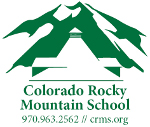Colorado Rocky Mountain School - Connecting the dots between gardening and education
by Linda Halloran, CRMS Organic Garden Learning Center Program Coordinator
Colorado Rocky Mountain School Blog
As a young child in school, I was given workbook pages with dots and numbers. My task was to merge my fledgling sense of numeracy and fine motor skills with a pencil, follow a sequence, and connect the dots. My reward was to see an entire picture emerge from those once-separate points. As I gained the ability to think and act in more complex ways, my education moved on to more complex tasks, but frequently my best teachers continued to lay out the reference points and expected me to use my growing intellect to connect the dots and create my own knowledge.
My goal in the Colorado Rocky Mountain School garden is to provide some of the dots that students can connect, with those from work in the classroom and personal experiences, to create their own picture of a world beyond the school. In the garden, first and foremost, students are involved in hard physical work—based on founders John and Anne Holden’s belief in its inherent value. But sometimes, as we work, we talk also about the social and environmental issues surrounding how our food typically ends up on our plates. Students begin to connect the dots. They bring what they have learned in the classroom to those discussions, whether from reading about the environmental and social costs of conventional food production in the Politics of Food class or from having studied groundwater contamination from the overuse of pesticides and fertilizers in Environmental Science classes.
Beyond the discussions, their time in the garden provides students with a real, visceral reinforcement of the abstract. Planting a seed and seeing the seedling sprout days later is biology in action. Picking beans for an hour in the heat of a September afternoon will never match what a migrant farm laborer experiences working fourteen-hour days, but it opens a small window into that experience. It allows students to make a connection between reading about the plight of laborers and what the student experienced of the tedium and discomfort of doing stoop labor. Carrying fifty pounds of freshly dug carrots into the CRMS kitchen is a real and tangible alternative to eating carrots trucked thousands of miles: it illustrates the local food movement on the most basic level.
On the abstract level, time in the garden provides students with a chance to see that an activity, which is good for the community and the world, can also provide personal satisfaction—that there is joy in a job well done. Most important, time in the garden provides students with a way to make a connection between thinking and doing—that the two aspects, the theoretical and the practical, need to be linked for a meaningful life.Students at CRMS have always had a talent for relating the many reference points from their time in the classroom and in the active curriculum in order to create a cohesive whole—to leave CRMS and do amazing things. I believe our job as educators is to provide content and context but to step back and trust that, with time, our students will do the heavy lifting and make the intellectual and practical connections to create the world they want.
Learn more about Colorado Rocky Mountain School
CRMS5407

